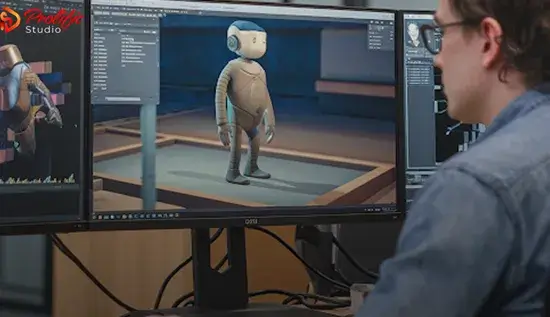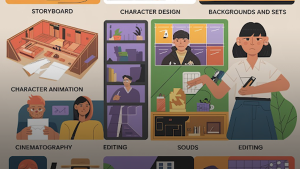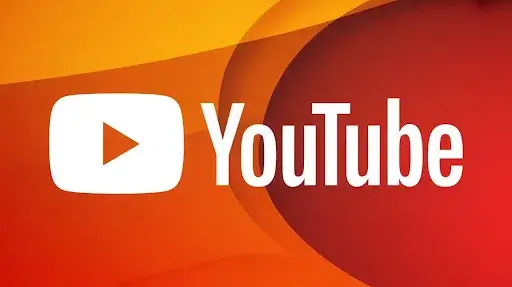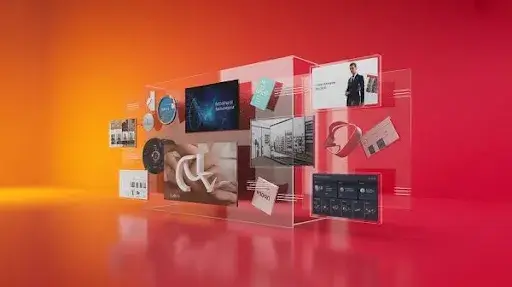The different industries in which 3D character animation has found its applications include education, product marketing, and gaming. A well-animated character is an important aid in storytelling, branding, and audience interaction. Hence, whether it is the use of animators for cinematic sequences, animated items for games, or explainer videos, the services of a 3D character animator are pivotal.
Fun fact: The animation industry is predicted to grow to $40 billion by 2028
This guide will open your eyes to some revelations about the hiring process for 3D character animators and what needs to be done, assessed, or designed in your portfolio.
Step 1: Define Your 3D Character Animation Needs
Understanding a project’s details requires one to first outline its goals, and expectations, which is one of the most important factors to consider when hiring a 3D character animator.
- Animation Purpose: What do you think the animation is for if it’s not for a video game or a movie? It could be an advertisement or even for training purposes in a corporate setting. And remember, each animator has a unique style to work on.
- Project Scope: Determine the number of animated characters, the animation length, and the complexity of the movements.
- Character Style: Define whether you need realistic human movements, cartoonish expressions, or fantasy-based designs.
- Budget and Timeline: For potential candidates, set realistic goals for them by coming up with a budget and timeline for the project.
Step 2: Understand the Role of a 3D Character Animator
3D character animators are responsible for breathing life into digital characters. They use specialized software to create realistic or stylized movements based on the project’s needs. Key responsibilities include:
- Rigging characters to create a digital skeleton for realistic movement.
- Animating character expressions, body language, and interactions.
- Refining motion to ensure smooth transitions and emotional expression.
Step 3: Research Potential Candidates
There are several ways to find talented 3D character animators:
1. Online Platforms and Job Boards
- Upwork and Fiverr: Freelancers with portfolios and client reviews.
- LinkedIn: A professional site where you can share job openings or seek experts.
- ArtStation and Behance: Sites featuring elite 3D artists and animators.
2. Animation Studios and Agencies
- If the scale of the project is wider in scope, you may consider hiring a company specialized in 3D animation since they have a team of experts who can answer your questions effectively.
- Prolific Studio targets trainers and marketers alike as they specialize in providing 3D character animation.
Step 4: Evaluate Portfolios and Experience
A robust portfolio is the most reliable sign of an animator’s creativity and skill level.
What to Look for in a Portfolio:
- Diverse Animation Styles: The portfolio must display a range of character styles featuring human characters, animal characters, and fantasy characters.
- Consistency: Ensure that the quality remains consistent across multiple projects.
- Relevant Experience: Seek employment that corresponds with your project (for instance, lifelike character animation for a game or whimsical animation for an explainer video).
- Fluidity of Motion: Verify for seamless transitions, fluid motion, and realistic expressions.
Experience Considerations:
- Years in the Industry: An experienced 3D character animator will likely deliver work faster and with fewer revisions.
- Specialization: Certain animators focus on particular fields, including game assets, cinematics, or facial animation.
Read also: Triple-A Games 2025: What They Are, Upcoming Releases, and Industry Trends
Step 5: Ask the Right Questions During Interviews
When interviewing potential animators or agencies, ask questions to gauge their expertise and workflow.
Key Questions to Ask:
- What animation software do you use? Common tools include Blender, Maya, 3ds Max, and Cinema 4D.
- Can you walk me through your animation process? Understanding their workflow helps you set expectations.
- How do you handle rigging and skinning? This ensures that the characters’ skeletons are properly set up for complex movements.
- Do you create custom character models or work with pre-existing models? Depending on your project, you may need a fully custom character or modifications to existing assets.
- How do you manage revisions and client feedback? Clarify how many revision rounds are included.
Step 6: Compare Freelancers vs. Animation Studios
If you are looking to bring down the cost of your project, hiring people on a freelance basis for smaller projects is your best bet. But most times, animation studios are equipped to handle larger projects.
Freelancers
- Pros:
- Lower cost.
- Flexibility in scheduling.
- Cons:
- Limited resources.
- Longer timelines if the project is large.
Animation Studios
- Pros:
- Availability of a group of specialists comprising modelers, animators, and sound designers.
- Faster turnaround for large-scale projects.
- Cons:
- Higher cost compared to hiring an individual freelancer.
Step 7: Request a Detailed Proposal
Once you’ve shortlisted candidates, request a formal proposal that outlines:
- Project milestones and deadlines.
- Animation style guidelines.
- Budget breakdown.
- Revision policy.
A clear proposal helps set expectations and provides a roadmap for the project.
Step 8: Understand the Animation Process
To collaborate effectively, it’s helpful to understand the key stages of 3D character animation.
1. Pre-Production
- Scriptwriting and concept development.
- Storyboarding and animatic creation.
2. Character Modeling and Rigging
- Building the 3D character mesh.
- Adding a digital skeleton (rig) to allow movement.
3. Animation and Motion Capture
- Keyframe animation or motion capture integration.
- Refining movements, gestures, and expressions.
4. Texturing and Lighting
- Adding surface details (textures).
- Creating realistic or stylized lighting effects.
5. Rendering and Post-Production
- Rendering final frames.
- Adding sound effects, background music, and special effects.
Step 9: Review and Provide Feedback
Sharing ideas and some pointers to your animation studio throughout your project is very important, this makes sure that all parties involved know exactly what is expected during each key stage of the project.
Tips for Effective Feedback:
- Be specific: Point out exact timestamps or sequences.
- Prioritize feedback: Highlight essential changes versus minor tweaks.
- Stay organized: Use collaborative tools for review and approval.
Step 10: Final Delivery and Post-Launch Support
Once the final animation is delivered, ensure that:
- The files are in the correct format (MP4, MOV, etc.).
- You have access to all project assets.
- The animator provides support for any minor post-launch fixes.
Common Pitfalls to Avoid When Hiring a 3D Character Animator
- Rushing the Hiring Process: Take time to evaluate portfolios and past work.
- Unclear Expectations: Clearly communicate your goals, style preferences, and deadlines.
- Skipping Contract Review: Always review the agreement to ensure it covers timelines, payment terms, and intellectual property rights.
You may also like: How Animated Logos Can Increase Brand Relevance?
FAQs
- What is the time required to produce a 3D character animation?
The duration needed for the majority of projects ranges between 4 to 8 weeks for animation.
- What is the price for 3D character animation services?
The usual expenses for an animation project vary between $3,000 and $20,000. It significantly changes based on the scope of the project and the design of the animation.
- Which software is utilized by professional animators?
Common software options are Blender, Maya, and 3ds Max.
- Should I create a storyboard before engaging an animator?
While it is not a requirement, studios do offer services for storyboard creation, but they do aid significantly in the process.
- Can I request character redesigns mid-project?
Yes, but it may extend the timeline and increase costs. - What’s the difference between rigging and keyframe animation?
Keyframe animation allows movement to be introduced toward characters, while rigging allows setting up a bone structure for them.
- Can animators create voice-synced facial expressions?
Yes, skilled animators can synchronize lip movements with voiceovers. - What file formats are delivered?
Common formats include MP4, MOV, and OBJ for 3D assets. - Can I use the animation for AR/VR projects?
Yes, many animations can be optimized for AR/VR platforms. - How many revision rounds are included?
Most studios offer 2-3 revision rounds as part of their packages. - Do animators handle sound design?
Some studios provide sound design, while others focus solely on visuals. - Can I use pre-made character rigs?
Yes, pre-made rigs can reduce costs and production time. - What’s the role of mocap in character animation?
Real-life movements are captured and applied to digital animators through motion capture or mocap technology.
- How do I choose between realistic and stylized animation?
Consider your audience and project tone; realistic styles suit training videos, while stylized animations work well for entertainment. - Is collaboration possible during remote projects?
Yes, studios use online tools for remote collaboration and feedback. - What is the typical animation length for marketing videos?
Most marketing animations are 30 seconds to 2 minutes. - Can I add subtitles and voiceovers?
Yes, subtitles and voiceovers can be added during post-production. - How do I retain rights to the animation?
Ensure the contract specifies intellectual property rights. - Can animators create animations for video games?
Yes, many animators specialize in creating game-ready character assets. - How do I get started with hiring a 3D character animator?
Contact a professional animation studio with your project details to receive a proposal.
Why Choose Prolific Studio for 3D Character Animation Services?
If you are looking for end to end 3D character animation services custom to your industry requirements, then you should definitely consider getting in touch with Prolific Studio. Our experienced team creates outstanding animations for movies, games, advertisements, and training materials.
- Cutting-Edge Tools: We use industry-leading software to deliver high-quality animations.
- Collaborative Process: We emphasize client input to guarantee the final product matches your vision.
- Diverse Portfolio: Having a lot of experience across many different industries makes us a reliable partner for animation services in general.
Call to Action
Ready to bring your characters to life? Contact Prolific Studio today for a tailored consultation and quote.









